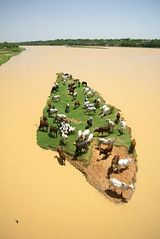 New options should focus on helping hungry animals and people adapt to climate change while mitigating the greenhouse gas emissions of small-scale livestock production systems.
New options should focus on helping hungry animals and people adapt to climate change while mitigating the greenhouse gas emissions of small-scale livestock production systems.
Farm animals have been providing the world with an uncommon array of benefits since before the dawn of agriculture. Indeed, most small-scale farming even today would be impossible without them. But it is the world’s poorest people—some one billion of them—who depend on cattle, sheep, goats, chickens and other domestic animals the most. Livestock keeping helps them sustain their herding cultures or small-scale farming (e.g., animal manure fertilizes croplands; cattle and buffalo pull ploughs and transport farm produce to markets). Livestock provide them with a rare means of earning and saving an income (people can sell milk, eggs, manure or surplus stock, or they can find jobs in dairy or related businesses). Livestock foods feed hungry people (families can consume the milk, meat and eggs their stock produce or sell these high-quality foods to buy cheaper starchy foods). And livestock are a last hedge to protect households against the shocks common to the rural poor—from drought, flood or disease that destroys food crops in the field, to market distortions that make farm produce worthless, to civil unrest that makes people flee their homes, and, finally now, to a warmer world with increasingly unpredictable weather and extreme weather events.
But the inexorable rise of human populations, along with the aspirations and appetites of their growing middle classes, have led also to global livestock populations of increasing numbers and increasingly intensive livestock production practices. While overconsumption of red meat and other livestock foods is damaging the health of many people of the North, under-consumption of these nourishing foods is hurting, and killing, many people of the South. In terms of the environment, livestock production globally causes up to 18% of the human-generated greenhouse gases that are warming our planet. Livestock do this both directly (methane, for example, is produced in the rumination processes of cud-chewing animals) and indirectly (such as the felling of forests to make room for fodder crops and ranching). The factory farms of industrialized countries not only can treat animals inhumanely but also can pollute air and water and threaten human as well as animal health. The herding and farming families of developing countries, on the other hand, typically maintain their ruminant animals on poor-quality feeds that make conversion of feed to milk and meat inefficient and environmentally damaging—skinny ruminants on poor diets, while not competing with people for grain, produce much more methane per unit of livestock product than do well-fed cattle, sheep and goats.
Just one hundred years ago, the principles and practices of animal husbandry were pretty similar across all the regions of the world where it was practiced (which pretty much meant all the regions of the world). But as schisms have opened up between the livestock production systems and peoples of today’s rich and poor worlds, we must now start from a new understanding—an understanding based on decades of livestock and systems research—that ‘local context’ is everything.
In the North, we need to focus on mitigating the impacts of livestock production and consumption on climate change. We already have many workable and alternative ways of reducing greenhouse gas emissions and the environmental and health ‘bads’ of intensive livestock production systems. We need to get them implemented and to begin monitoring our reductions in livestock-produced greenhouse gases as we begin to build more sustainable and healthy food systems.
In the South, where most of the world’s poor live, work and are fed by hundreds of millions of small-scale farmers and herders, the impacts of climate change will be greatest—and typically experienced at first hand. These farmers and herders include the largely rainfed crop-and-livestock farming communities that, unknown to many, have become the world’s biggest source of staple foods for the poor as well as many of the world’s most renowned herding cultures.
In the rural South, there are few ways of making a living other than by producing food from the land. Therefore, while we need to encourage people to mitigate the greenhouse gas emissions generated by their livestock enterprises, we need to focus most urgently on helping these people and communities to adapt their production systems to climate change. New incentives and technology and policy instruments should allow them to continue to provide the foods, jobs, livelihoods and environmental services that their livestock make possible and doing so in increasingly more efficient and sustainable ways.
With a perfect storm of food, water and energy shortages fast approaching—and 1 billion livestock livelihoods at the very centre of a nexus of human, climate and environmental vulnerabilities—the time for helping developing countries and communities to transform their livestock sectors has come.
As we move further into a 21st century characterized by depleted natural resources and the projected ‘human tsunami’ that is expected to peak by mid-century with a population of more than 9 billion, those of us in research for development need to focus our energy and attention on the little- as well as well-known levers that drive big change.
Across the developing regions of Africa, Asia and Latin America, the raising and selling of farm animals, and the increasing consumption of milk, meat and eggs, together represent one of those ‘big-change’ levers. The ubiquitous small-scale livestock enterprises found in every country of the developing world can represent pathways out of poverty and hunger. They can also promote climate change. Livestock researchers are acutely aware that they are working at these critically important crossroads.
This is Chapter One of the ILRI Corporate Report 2008–09: Download the full report

